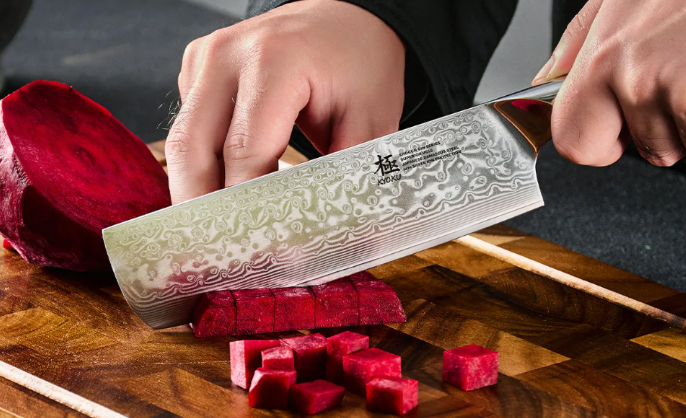Introduction
Japanese knives hold a revered place in kitchens worldwide, from high-end culinary establishments to home kitchens. Renowned for their sharpness, precision, and balance, these knives represent more than just cutting tools; they embody a rich cultural heritage of craftsmanship. Japanese knifemaking techniques, passed down through generations, combine traditional forging methods with high-quality materials to create knives that are both functional and beautiful. In this article, we’ll explore the unique artistry behind some of the best Japanese knives, covering the legacy of Japanese bladesmiths, the high-grade materials that define these knives, various blade profiles tailored to specific culinary tasks, and tips for care.
The Cultural Heritage and Art of Japanese Knifemaking
Japanese knifemaking is rooted in centuries-old traditions that date back to the era of samurai swords. Blacksmiths who once forged katanas transitioned to crafting kitchen knives as Japan’s society evolved, bringing a unique approach to blade-making that focuses on balance, functionality, and aesthetic simplicity. This philosophy—deeply embedded in Japanese culture—values harmony and respect for materials, which comes through in the meticulous creation of each knife.
High-Quality Materials that Set Japanese Knives Apart
One of the key reasons Japanese knives are so highly regarded is the quality of materials used. The selection of steel greatly influences the knife’s performance, sharpness, and durability.
- Carbon Steel: Known for its superior sharpness, carbon steel is commonly used in traditional Japanese knives. Although it requires more maintenance to prevent rust, it offers unparalleled edge retention, making it ideal for chefs who prioritize precision.
- Stainless Steel (e.g., VG10): This modern steel combines high sharpness with rust resistance, making it a popular choice for chefs looking for durability and ease of maintenance.
- White and Blue Steels (Shirogami and Aogami): White steel, or Shirogami, provides an extremely sharp edge but can be prone to rust. Blue steel, or Aogami, adds chromium for enhanced durability, balancing sharpness with improved resistance to corrosion.
Japanese knives often use a technique called “cladding,” where hard steel is layered with softer materials to protect the blade and enhance performance. This construction creates a knife that not only holds an edge well but also resists chipping, making it both durable and precise.
The Distinctive Blade Profiles and Their Culinary Functions
Each Japanese knife is designed with a specific purpose, ensuring that chefs have the right tool for every task. Kyoku Japanese knives, renowned for their craftsmanship and performance, offer an excellent range of knives. Combining traditional Japanese design with modern durability, Kyoku knives are a trusted choice for both home chefs and professionals.
- Gyuto knife(Chef’s Knife): A versatile, multi-purpose knife, the Gyuto is often likened to the Western chef’s knife. Its slender design allows for precise cuts, whether slicing meat, dicing vegetables, or even filleting fish.
- Honesuki (Boning Knife): The Honesuki is a Japanese boning knife tailored for breaking down poultry and deboning meat. Its triangular blade offers excellent precision for working around joints and bones. Unlike Western boning knives, which are often more flexible, the Honesuki is stiff and robust, allowing it to handle tougher cuts.
- Steak Knives: Combining precision and elegance, Japanese steak knives feature razor-sharp blades designed for slicing through steaks and meats effortlessly. Often made from high-carbon stainless steel or Damascus steel, these knives maintain the integrity of the meat by ensuring precise cuts without tearing.
- Santoku: The Santoku, meaning “three virtues,” is designed for slicing, dicing, and mincing. Its slightly curved edge makes it ideal for home chefs who need an all-around knife for various tasks.
- Nakiri: The Nakiri knife features a flat edge, making it perfect for chopping vegetables with precision. Its unique shape encourages a straight-down chopping motion, which is ideal for preparing vegetables and herbs.
- Yanagiba: A long, slender, single-beveled knife, the Yanagiba is crafted for slicing sashimi and sushi. Its design minimizes drag when slicing through delicate fish, allowing for clean cuts without tearing.
Each knife profile is tailored to specific culinary tasks, ensuring that chefs can execute precision and efficiency in every cut.
The Intricate Crafting Process
Creating a Japanese knife is a meticulous process that requires skill and patience. It begins with forging, where the steel is heated, hammered, and shaped to form the blade. This step, often done by hand, ensures the knife’s structural integrity and strength.
Once forged, the knife undergoes tempering and hardening, refining the blade’s sharpness and durability. Sharpening is usually done on whetstones, with artisans carefully honing each edge to ensure maximum sharpness. Finally, the knife is polished, and a handle is crafted from materials like wood or resin, providing balance and enhancing grip. This intensive process combines functionality with artistry, resulting in a knife that is both beautiful and effective.
Advantages of Using Japanese Knives
Japanese knives offer a range of benefits that have made them a favorite among chefs and cooking enthusiasts.
- Precision and Sharpness: Japanese knives are designed to hold a sharp edge, allowing chefs to make clean, precise cuts, which is especially important in delicate dishes like sushi.
- Lightweight and Balanced Design: The ergonomic build of Japanese knives reduces hand fatigue, making them ideal for long hours in the kitchen. Their lightweight construction allows for more agile movements, enhancing control.
- Edge Retention and Easy Sharpening: Due to high-quality steels, Japanese knives retain their sharpness longer than many Western counterparts. When they do need sharpening, the process is straightforward, often done with a whetstone to maintain their fine edge.
Tips for Caring for Japanese Knives
To keep a Japanese knife in top condition, proper care is essential.
- Cleaning and Drying: Japanese knives should be hand-washed and dried immediately after use to prevent rust and stains.
- Sharpening with Whetstones: Sharpening should be done periodically with whetstones, which help maintain the edge while preserving the integrity of the blade.
- Storage Recommendations: Store Japanese knives on magnetic racks or in wooden knife blocks to prevent accidental damage to the blade.
By following these care guidelines, you’ll ensure that your Japanese knife remains sharp and functional for years to come.
Conclusion
Japanese knives are more than just kitchen tools; they are works of art, blending tradition, craftsmanship, and performance. From the rich cultural heritage behind their creation to the high-quality materials and specialized designs, each Japanese knife brings something unique to the culinary experience. Though an investment, Japanese knives offer durability, sharpness, and precision that elevate any cooking experience, making them a valuable addition to any kitchen.

